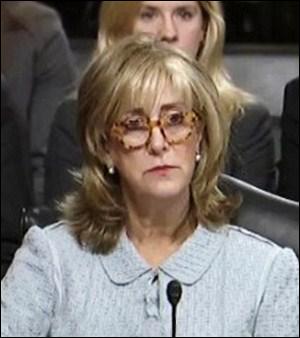By Pam Martens: March 19, 2013

Ina Drew, Former Head of the Chief Investment Office at JPMorgan, Testifying at the March 15, 2013 Senate Hearing on the London Whale Trading Losses
Gambling on high-risk synthetic credit derivatives is not the only area of interest at JPMorgan’s Chief Investment Office (CIO) – the division that has thus far admitted to losing $6.2 billion in the London Whale debacle. According to Exhibit 81 released by the U.S. Senate’s Permanent Subcommittee on Investigations, Ina Drew, the head of the CIO, was also overseeing the investment of funds in the firm’s Bank Owned Life Insurance (BOLI) and Corporate Owned Life Insurance (COLI) plans – a scheme enshrined by the U.S. Congress in 2006 that allows too-big-to-fail banks as well as many other corporations to reap huge tax benefits by taking out life insurance policies on workers – even low wage workers – and naming the corporation the beneficiary of the death benefit.
According to the exhibit, Drew was tasked with “Maximization of tax-advantaged investments of life insurance premiums” for the BOLI/COLI plans. According to a report in the Wall Street Journal in 2009, JPMorgan had $12 billion in BOLI, noting that a JPMorgan spokesperson had confirmed the figure. Other insurance industry experts put the total for both BOLI and COLI at JPMorgan significantly higher.
Most Americans are unaware that for at least 25 years big business and banks have been secretly taking out millions of life insurance policies on their workers and naming the corporation the beneficiary of the death benefit without the knowledge of the employee. The individual policies are frequently in the hundreds of thousands of dollars and sometimes millions. To keep track of employees who have left the company, deaths are routinely tracked through the Social Security Administration. The policies became known as “dead peasant” or “janitor” policies because corporations took out life insurance on millions of low-wage workers, including janitors, without their knowledge or consent.
The insurance can give a nice boost to bottom-line corporate profits because it provides multiple tax breaks, including: the cash buildup in the policy is reported as income but is tax-exempt because it resides in a tax-sheltered life insurance policy; the cash payment the company receives when the employee dies is also tax-free under existing tax law.
In 2003, the General Accountability Office (GAO) released a study which found that multiple companies held policies on the same individual and that 3,209 banks and thrifts had current cash values in these policies totaling $56.3 billion.
In 2006, Congress passed the Pension Protection Act. Instead of outlawing this dubious practice, Congress grandfathered all of the millions of previously issued policies while imposing a few tax and reporting rules.
A study by Susan Lorde Martin, Professor of Business Law at Hofstra University in Uniondale, New York found that Portland General, at the time a subsidiary of Enron, had created a COLI arrangement where the death of low-wage workers was funding lavish compensation plans for top executives. Martin writes: “About seventy-five percent of an estimated $80 million in benefits from the policies pays for a long-term compensation plan for managers, directors, and other top officers; the other twenty-five percent contributes to a supplemental executive retirement plan. Workers who have had their entire retirement funds of hundreds of thousands of dollars wiped out by Enron’s collapse were shocked to discover that their deaths will support benefit plans for top Enron executives.”
In a presentation made by JPMorgan Asset Management, apparently to sell its own investment services for managing monies in other firms’ COLI or BOLI plans, JPMorgan explains how companies can smooth earnings volatility with these plans:
Under a heading of “GAAP Accounting Treatment,” JPMorgan notes:
“Income Statement: ‘Other Income,’ ‘above the line treatment due for income is recurring in nature.’ Please note that BOLI is accounted for under FASB 85-4 which states that the asset is booked at ‘net realizable value.’ Therefore, all realized and unrealized gains and losses of the contract are booked through the income statement which is similar to how a trading security is treated under FASB 115. Because of this treatment, many financial institutions have found it advantageous to ‘wrap’ their BOLI assets with Stable Value Protection to achieve a book value accounting treatment whereby gains and losses are amortized over a period of time to minimize period to period volatility.”
Last week, on March 15, Senator Carl Levin convened a Senate hearing to take further testimony on the CIO losses at JPMorgan. In his opening remarks, the Senator confirmed that the speculative trades had been made with insured deposits held at the bank – not the firm’s own capital – and that JPMorgan had the lowest ratio of any bank in terms of lending out those insured deposits rather than using them for risky derivative gambles.
Senator Levin stated:
“JPMorgan’s Chief Investment Office rapidly amassed a huge portfolio of synthetic credit derivatives, in part using federally insured depositor funds, in a series of risky, short-term trades, disclosing the extent of the portfolio only after intense media exposure…
“It was recently reported that the eight biggest U.S. banks have hit a five-year low in the percentage of deposits used to make loans. Their collective average loan-to-deposit ratio has fallen to 84 percent in 2012, down from 87 percent a year earlier, and 101 percent in 2007. JPMorgan has the lowest loan-to-deposit ratio of the big banks, lending just 61 percent of its deposits out in loans. Apparently, it was too busy betting on derivatives to issue the loans needed to speed economic recovery.”
The primary reason banks exist is to make sound business loans that will create jobs and new industries to help the U.S. remain competitive and to enhance the standard of living for all Americans. What we see at JPMorgan is something radically different.

